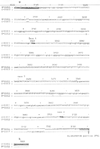Genotyping: the HLA system and embryo development
- PMID: 12470575
- PMCID: PMC2557436
- DOI: 10.1016/s1472-6483(10)61930-x
Genotyping: the HLA system and embryo development
Abstract
The human major histocompatibility complex (MHC), in addition to its role in the regulation of cell-cell interactions in the immune response, also influences reproductive success. Human leukocyte antigen-G (HLA-G) is an MHC class I gene of particular interest in reproductive biology because of its specific expression on fetal cytotrophoblast cells, and its reported involvement both in protection of the developing fetus from destruction by the maternal immune response and in the prevention of maternal pre-eclampsia. HLA-G has 15 known alleles at the DNA level, and allelic frequency varies among ethnic groups. This study describes the results of an inaugural attempt to correlate an HLA-G genetic polymorphism with pregnancy outcome in a patient population undergoing IVF. The study group was composed of 102 Caucasian women. A maternal HLA-G genetic polymorphism was investigated by polymerase chain reaction (PCR) analysis of DNA collected from granulosa cells surrounding oocytes harvested for the IVF procedure. While no statistically significant correlation was identified in this initial study, larger studies examining DNA from trios of mother, father and offspring are planned.
Figures



Similar articles
-
Association between human leukocyte antigen-G genotype and success of in vitro fertilization and pregnancy outcome.Tissue Antigens. 2004 Jul;64(1):66-9. doi: 10.1111/j.1399-0039.2004.00239.x. Tissue Antigens. 2004. PMID: 15191524
-
Co-dominant expression of the HLA-G gene and various forms of alternatively spliced HLA-G mRNA in human first trimester trophoblast.Hum Immunol. 1998 Feb;59(2):87-98. doi: 10.1016/s0198-8859(97)00259-0. Hum Immunol. 1998. PMID: 9536431
-
Genetic analysis of insulin-like growth factor II and HLA-G in pre-eclampsia.Biochem Soc Trans. 2000 Feb;28(2):215-9. doi: 10.1042/bst0280215. Biochem Soc Trans. 2000. PMID: 10816131
-
HLA-G in human reproduction: aspects of genetics, function and pregnancy complications.Hum Reprod Update. 2006 May-Jun;12(3):209-32. doi: 10.1093/humupd/dmi048. Epub 2005 Nov 9. Hum Reprod Update. 2006. PMID: 16280356 Review.
-
HLA-G polymorphisms: neutral evolution or novel function?J Reprod Immunol. 1997 Nov 30;36(1-2):1-21. doi: 10.1016/s0165-0378(97)00062-4. J Reprod Immunol. 1997. PMID: 9430736 Review.
Cited by
-
Association of parental HLA-G polymorphisms with soluble HLA-G expressions and their roles on recurrent implantation failure: A systematic review and meta-analysis.Front Immunol. 2022 Dec 1;13:988370. doi: 10.3389/fimmu.2022.988370. eCollection 2022. Front Immunol. 2022. PMID: 36532068 Free PMC article.
References
-
- Allcock RJ, Martin AM, Price P. The mouse as a model for the effects of MHC genes on human disease. Immunology Today. 2000;21:328–332. - PubMed
-
- Bainbridge DR, Ellis SA, Sargent IL. The short forms of HLA-G are unlikely to play a role in pregnancy because they are not expressed at the cell surface. Journal of Reproductive Immunology. 2000;47:1–16. - PubMed
-
- Beck S, Trowsdale J. The human major histocompatibility complex: lessons from the DNA sequence. Annual Review of Genomics and Human Gentiles. 2000;1:117–137. - PubMed
-
- Beck S, Geraghty D, Inoko H, Rowen L. Complete sequence and gene map of a human major histocompatibility complex. The MHC sequencing consortium. Nature. 1999;401:921–923. - PubMed
Publication types
MeSH terms
Substances
Grants and funding
LinkOut - more resources
Full Text Sources
Research Materials

